
Park offers unique camping location
HOMESTEAD, Fla. — My idealistic view of “camping” is preferably somewhere deep and secluded in the mountains, among towering trees, vegetation and perhaps even a little snow.
Located at the southern tip of mainland Florida, Everglades National Park does not offer this idealistic setting for camping.
What the park does offer is a unique locale to view birds and other wildlife, with warm temperatures and a stunning view of the night sky. Rather than pitching a tent at thousands of feet in altitude, I made my way to camp in a place where no piece of the land is more than 10 feet above sea level.
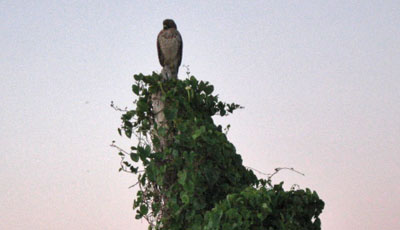 |
An osprey keeps watch over the Flamingo campground (Photos by Lauren Shepherd). |
The journey to Flamingo Campground in Everglades National Park appears quite simple. While on highway U.S. 1 heading south, signs in Florida City to “Everglades National Park” will lead the way to the park. Unfortunately, the route Google Maps generates for “Flamingo Campground, Homestead, FL” directed my friend and I to turn at a road that we could not locate.
We took numerous wrong turns trying to follow the Google directions, not knowing that the signs to Everglades National Park were just a few minutes down the road.
For those unfamiliar with the drive to the Everglades, some of the directions sound rather bizarre, like something from a movie. For example, we were instructed to “turn left at the ‘Robert is Here’ fruit stand, and then turn right at the prison.”
| The Robert is Here fruit stand is a popular stop for visitors on the way to Everglades National Park. | 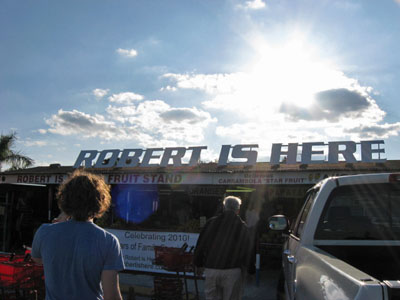 |
Those that have been to the Everglades before probably know that the key lime milkshakes at the Robert is Here fruit stand are more than worth the stop. In the land behind the store, there are macaws and even a small petting zoo.
The main entrance to the park is located just a few miles away from the Robert is Here fruit stand. The campground located closest to the main entrance is Long Pine Key, which is just six miles into the park. The other is Flamingo Campground, which is another 32 miles into the park, but definitely worth the extra travel time.
The drive itself is quite peaceful, with stops along the main road for various trails and picnic spots.
Flamingo Campground offers walk-up sites closer to the beach with a view of the bay, and drive-in sites where you can park right next to your tent. We chose to park a bit further away and walk to a campsite, where we could have a view of the bay.
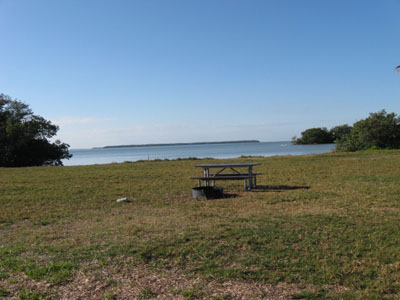 |
At left, a walk-up campsite at the Flamingo camp- ground offers a view of the bay. Below, a view of various tents at the walk-up campsites. |
It seemed the walk-in sites hosted the quieter campers: families, couples and small groups. The drive-in spots seemed to have a slightly louder crowd, but perhaps this was just the case for the particular night we were camping.
The campground does not offer any sort of isolation from your neighbors. You can see and hear everything, particularly before the sun sets. Despite being surrounded by other campers, the campground still elicits a feeling of serenity.
Everyone camping is generally there for the same purpose: to escape from the city into nature. Despite the close proximity to other people, the campground is still quite tranquil, as everyone is of like mind.
Restrooms are located nearby, with cold showers and even a few power outlets. Each campground has a picnic table and grill where you can build a fire with dead wood on the ground or wood that you bring in.
While walking back to the car to get more supplies, I saw an Osprey perched on a nearby tree. Many people come to the Everglades to go bird watching, and I can understand why. It really is unique to see birds and other wildlife when they are actually in the wild, not in a cage in the middle of a city.
When it comes to spending time in the great outdoors, I generally fall somewhere in the category of “nature lover with a fear of bugs and rain.” Luckily, there was no rain in the forecast. Bugs were another story.
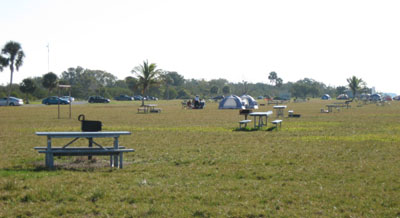 Inside the visitor center at Flamingo is a “mosquito meter,” which shows just how much of a nuisance the little bloodsuckers are going to be for the day. The meter ranges from “Enjoyable” to “Hysterical.” On my particular trip, it was right in the middle at “Unpleasant.”
Inside the visitor center at Flamingo is a “mosquito meter,” which shows just how much of a nuisance the little bloodsuckers are going to be for the day. The meter ranges from “Enjoyable” to “Hysterical.” On my particular trip, it was right in the middle at “Unpleasant.”
“Be sure to check for high levels of mosquitoes before coming,” said Maria Ortiz, a Davie, Fla., resident who has camped at Flamingo more than five times.
Ortiz brought her kids to the campground when they were younger.
“If parents want to expose their kids to camping, you have to make sure they don’t suffer.”
When it comes to combating mosquitoes, fire and bug spray are your best allies for enjoying the experience. Check the weather forecast beforehand, as chilly nights with wind are likely to keep the mosquitoes away.
The visitor’s center and campground are run mostly by volunteers who come from all over the country to dedicate a few months of their time preserving nature.
“We do it because we love it,” said Marge Seager, a volunteer from New Hampshire who came to the Everglades with her husband Bruce.
“The hype about the snakes made me afraid, but I haven’t seen one python yet,” said Seager.
Burmese pythons are an invasive species not native to the area. The snakes likely started inhabiting the Everglades when they were released from their owners as unwanted pets, or when they migrated to the everglades when their previous habitats were destroyed by hurricanes.
The Seagers told me that a freeze in January killed many fish and around 30 manatees in the area died from the cold. Despite these losses, the cold winter temperatures did provide one benefit. Some pythons died from the freeze itself, and other pythons came out into the open, hoping to find warmth from the sun.
This put the species in an easier position to be killed by hunters. It is estimated that the python population was reduced by 50 percent during the winter months, which makes it a more inviting atmosphere for campers who are wary of snakes.
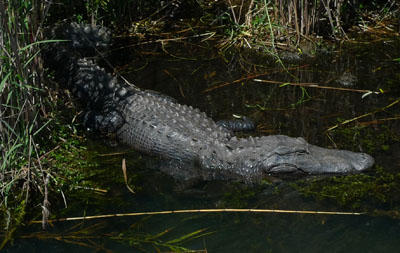 |
An alligator lurks in the water near the Anhinga trail in Royal Palm. |
Though many campers may choose to sleep through the wee hours of the morning, the early risers enjoy a rather spectacular view of the sunrise.
“In the mornings, you see a lot of people doing yoga and meditating outside,” said Ortiz. “I think the park provides a sanctuary for people who are stressed.”
Daytime at the park is perfect for bird watching and observing wildlife, whether in the campground itself or at a stop off the main road. The visitor’s center offers many free ranger-led activities at Flamingo during the day, such as morning canoe trips, bird walks, and lectures on different topics.
“If you’re visiting the park, you have to make a stop at Royal Palm,” said Rita Huston, a volunteer in her 13th season at the park.
While the two trails in Royal Palm offer excellent close-up views of birds and crocodiles, it is also worthwhile to stop at a few of the less populated trails along the main road. The walk through “Snake Bight” trail, located four miles north of the Flamingo Campground, was a shaded, picturesque journey. At the end of the 1.6-mile (one way) hike, there is a small boardwalk.
| An overview of the “Snake Bight” Trail, which offers scenic views and a more private experience than Royal Palm. | 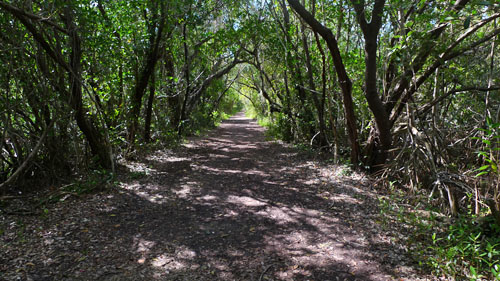 |
Once the sun has set, the campground takes on an entirely different feel. Many of the kids running around begin to settle down, and the general area becomes relatively quiet.
The night sky is absolutely breathtaking. The view of the stars alone makes the trip worthwhile. We were lucky enough to have a relatively cloud-less sky, and shooting stars were visible every few minutes.
“At night you can see all the constellations, as there’s no artificial light,” said Ortiz.
For those seeking a unique retreat into nature, camping in the Everglades is one avenue that provides escape from the stresses of everyday life.
If You Go
Directions: Take U.S. 1 South to Florida City. Turn right at Palm Drive (State Road 9336/SW 344th Street). There will be a sign for “Everglades National Park.” Turn left at the “Robert is Here” fruit stand (Tower Road), and then turn right at the prison (Ingraham Highway). There will be signs to the park at both turns. Continue on to Main Park Road.
Bring firewood, binoculars, a flashlight and bug spray.
A list of ranger-led activities are available online at http://www.nps.gov/ever/planyourvisit/, or contact 239-695-2945 for more information.
Reservations for Flamingo Campground can be made online at http://www.recreation.gov/.
The cost for entering the park in a vehicle is $10 and is good for seven consecutive days. Camping is $16 per night.

Comments are Closed